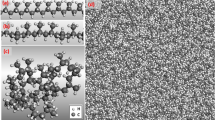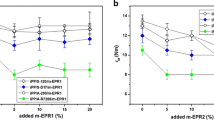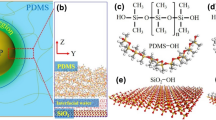Abstract
We investigate the mechanical behavior of polypropylene/silica composites under mode I and II loading by using molecular dynamics simulations, focusing on the effects of two typical surface coupling agents of HMDZ and APTES on the interface deformation and failure. It is found that under mode I loading, the silica surface functionalized with APTES can enhance the tensile strength of polypropylene/silica composites effectively. In contrast, the silica surface functionalized with HMDZ has little effect on the tensile strength. The simulation results are supported by experiments. Under mode II loading, it is found that both HMDZ and APTES can enhance the shear strength of polypropylene/silica composites with APTES being more effective. The underlying mechanisms for the enhancement of interface strength are analyzed. Our work provides a deep understanding of the interface structure, deformation and failure and will be useful for selecting suitable surface coupling agents in enhancing the interface strength of polymer composites.











Similar content being viewed by others
References
Pegoretti A, Dorigato A et al (2019) Encyclopedia of Polymer Science and Technology. John Wiley & Sons, Inc. https://doi.org/10.1002/0471440264.pst130.pub2
Shubhra QTH, Alam A, Quaiyyum MA et al (2011) Mechanical properties of polypropylene composites: A review. J Thermoplast Compos Mater 26:362–391. https://doi.org/10.1177/0892705711428659
Saba N, Tahir P, Jawaid M et al (2014) A review on potentiality of nano filler/natural fiber filled polymer hybrid composites. Polym 6:2247–2273. https://doi.org/10.3390/polym6082247
Natarajan B, Li Y, Deng H, Brinson LC, Schadler LS et al (2013) Effect of interfacial energetics on dispersion and glass transition temperature in polymer nanocomposites. Macromol 46:2833–2841. https://doi.org/10.1021/ma302281b
Adnan A, Sun CT, Mahfuz H et al (2007) A molecular dynamics simulation study to investigate the effect of filler size on elastic properties of polymer nanocomposites. Compos Sci Technol 67:348–356. https://doi.org/10.1016/j.compscitech.2006.09.015
Liu S, Böhm MC, Müller-Plathe F et al (2016) Role of the interfacial area for structure and dynamics in polymer nanocomposites: molecular dynamics simulations of polystyrene with silica nanoparticles of different shapes. Mater Res Express 3:105301. https://doi.org/10.1088/2053-1591/3/10/105301
Li ZQ, Liu ZS et al (2019) Energy transfer speed of polymer network and its scaling-law of elastic modulus-New insights. J Appl Phys 126:215101. https://doi.org/10.1063/1.5129621
Suter JL, Groen D, Coveney PV et al (2015) Chemically specific multiscale modeling of clay-polymer nanocomposites reveals intercalation dynamics, tactoid self-assembly and emergent materials properties. Adv Mater 27:966–984. https://doi.org/10.1002/adma.201403361
Yeo JJ, Jung GS, Martin-Martinez FJ, Ling SJ, Gu GX, Qin Z, Buehler MJ et al (2018) Materials-by-design: computation, synthesis, and characterization from atoms to structures. Phys Scr 93:053003. https://doi.org/10.1088/1402-4896/aab4e2
Wei QH, Zhang YF, Wang YE, Yang MM et al (2017) A molecular dynamic simulation method to elucidate the interaction mechanism of nano-SiO2 in polymer blends. J Mater Sci 52:12889–12901. https://doi.org/10.1007/s10853-017-1330-0
Wang F, Liu K, Li DC, Ji BH et al (2020) Fracture toughness of biological composites with multilevel structural hierarchy. J Appl Mech 87:071004. https://doi.org/10.1115/1.4046845
Zhai C, Li T, Shi H, Yeo J et al (2020) Discovery and design of soft polymeric bio-inspired materials with multiscale simulations and artificial intelligence. J Mater Chem B 8:6562–6587. https://doi.org/10.1039/D0TB00896F
Chen Y, Chia JYH, Su ZC, Tay TE, Tan VBC et al (2013) Mechanical characterization of interfaces in epoxy-clay nanocomposites by molecular simulations. Polym 54:766–773. https://doi.org/10.1016/j.polymer.2012.11.040
Yuan Z, Lu Z, Yang Z, Sun J, Xie F et al (2016) A criterion for the normal properties of graphene/polymer interface. Comput Mater Sci 120:13–20. https://doi.org/10.1016/j.commatsci.2016.04.006
Zhuang X, Zhou S et al (2018) Molecular dynamics study of an amorphous polyethylene/silica interface with shear tests. Mater 11. https://doi.org/10.3390/ma11060929
Min K, Kim Y, Goyal S, Lee SH, McKenzie M, Park H, Savoy ES, Rammohan AR, Mauro JC, Kim H, Chae K, Lee HS, Shin J, Cho E et al (2016) Interfacial adhesion behavior of polyimides on silica glass: A molecular dynamics study. Polym 98:1–10. https://doi.org/10.1016/j.polymer.2016.06.017
Mo YF, Yang CL, Xing YF, Wang MS, Ma XG, Wang LZ et al (2014) Effects of silica surface on the ordered orientation of polyethylene: A molecular dynamics study. Appl Surf Sci 311:273–278. https://doi.org/10.1016/j.apsusc.2014.05.055
Vo VS, Nguyen VH, Mahouche-Chergui S, Carbonnier B, Di Tommaso D, Naili S et al (2017) From atomistic structure to thermodynamics and mechanical properties of epoxy/clay nanocomposites: Investigation by molecular dynamics simulations. Comput Mater Sci 139:191–201. https://doi.org/10.1016/j.commatsci.2017.07.024
Maurel G, Goujon F, Schnell B, Malfreyt P et al (2015) Multiscale modeling of the polymer-silica surface interaction: from atomistic to mesoscopic simulations. J Phys Chem C 119:4817–4826. https://doi.org/10.1021/jp510979d
Buell S, Rutledge GC, Van Vliet KJ et al (2010) Predicting polymer nanofiber interactions via molecular simulations. ACS Appl Mater Interfaces 2:1164–1172. https://doi.org/10.1021/am1000135
Wang Y, Zhan HF, Xiang Y, Yang C, Wang CM, Zhang YY et al (2015) Effect of covalent functionalization on thermal transport across graphene-polymer interfaces. J Phys Chem C 119:12731–12738. https://doi.org/10.1021/acs.jpcc.5b02920
Meltonyan AV, Poghosyan AH, Sargsyan SH, Margaryan KS, Shahinyan AA et al (2020) The conformation of adsorbed poly (vinylimidazole) on gold surface: a molecular dynamics study. J Polym Res 27:91. https://doi.org/10.1007/s10965-020-02075-8
Maddah HA (2016) Polypropylene as a promising plastic: A review. Am J Polym Sci 6:1–11. https://doi.org/10.5923/j.ajps.20160601.01
Zu L, Li R, Jin L, Lian H, Liu Y, Cui X et al (2014) Preparation and characterization of polypropylene/silica composite particle with interpenetrating network via hot emulsion sol–gel approach. Pro Nat Sci-Mater 24:42–49. https://doi.org/10.1016/j.pnsc.2014.01.001
Mittal V (2009) Polymer layered silicate nanocomposites: A review. Mater 2:992–1057. https://doi.org/10.3390/ma2030992
Parvathy Rao A, Venkateswara Rao A et al (2010) Modifying the surface energy and hydrophobicity of the low-density silica aerogels through the use of combinations of surface-modification agents. J Mater Sci 45:51–63. https://doi.org/10.1007/s10853-009-3888-7
Pasternack RM, Amy SR, Chabal YJ et al (2008) Attachment of 3-(aminopropyl)triethoxysilane on silicon oxide surfaces: Dependence on solution temperature. Langmuir 24:12963–12971. https://doi.org/10.1021/la8024827
Acres RG, Ellis AV, Alvino J, Lenehan CE, Khodakov DA, Metha GF, Andersson GG et al (2012) Molecular structure of 3-aminopropyltriethoxysilane layers formed on silanol-terminated silicon surfaces. J Phys Chem C 116:6289–6297. https://doi.org/10.1021/jp212056s
Mahadik DB, Rao AV, Rao AP, Wagh PB, Ingale SV, Gupta SC et al (2011) Effect of concentration of trimethylchlorosilane (TMCS) and hexamethyldisilazane (HMDZ) silylating agents on surface free energy of silica aerogels. J Colloid Interface Sci 356:298–302. https://doi.org/10.1016/j.jcis.2010.12.088
Arabnejad S, Manzhos S, Shim VPW et al (2016) Effect of surface treatment on the mode I debonding of interface between silica and nylon6. MRS Adv 1:2717–2722. https://doi.org/10.1557/adv.2016.530
Qiao B, Wang TJ, Gao H, Jin Y et al (2015) High density silanization of nano-silica particles using gamma-aminopropyltriethoxysilane (APTES). Appl Surf Sci 351:646–654. https://doi.org/10.1016/j.apsusc.2015.05.174
Golub AA, Zubenko AI, Zhmud BV et al (1996) gamma-APTES modified silica gels: The structure of the surface layer. J Colloid Interface Sci 179:482–487. https://doi.org/10.1006/jcis.1996.0241
Meroni D, Lo Presti L, Di Liberto G, Ceotto M, Acres RG, Prince KC, Bellani R, Soliveri G, Ardizzone S et al (2017) A close look at the structure of the TiO2-APTES interface in hybrid nanomaterials and its degradation pathway: An experimental and theoretical study. J Phys Chem C 121:430–440. https://doi.org/10.1021/acs.jpcc.6b10720
Akkermans RLC, Spenley NA, Robertson SH et al (2013) Monte Carlo methods in Materials Studio. Mol Simulat 39:1153–1164. https://doi.org/10.1080/08927022.2013.843775
Plimpton S (1995) Fast parallel algorithms for short-range molecular dynamics. J Comput Phys 117:1–19. https://doi.org/10.1006/jcph.1995.1039
Sun H, Mumby SJ, Maple JR, Hagler AT et al (1994) An ab-initio CFF93 all-atom force-field for polycarbonates. J Am Chem Soc 116:2978–2987. https://doi.org/10.1021/ja00086a030
Diao JK, Gall K, Dunn ML et al (2004) Atomistic simulation of the structure and elastic properties of gold nanowires. J Mech Phys Solids 52:1935–1962. https://doi.org/10.1016/j.jmps.2004.03.009
Zimmerman JA, Webb EB, Hoyt JJ, Jones RE, Klein PA, Bammann DJ et al (2004) Calculation of stress in atomistic simulation. Modell Simul Mater Sci Eng 12:S319–S332. https://doi.org/10.1088/0965-0393/12/4/s03
Novak I, Florian S et al (2001) Study of the change in polarity of polypropylene modified in bulk by polar copolymers. J Mater Sci 36:4863–4867. https://doi.org/10.1023/a:1011895000500
Gu HW, Guo YB, Wong SY, He CB, Li X, Shim VPW et al (2013) Effect of interphase and strain-rate on the tensile properties of polyamide 6 reinforced with functionalized silica nanoparticles. Compos Sci Technol 75:62–69. https://doi.org/10.1016/j.compscitech.2012.12.004
Karger-Kocsis J, Mahmood H, Pegoretti A et al (2015) Recent advances in fiber/matrix interphase engineering for polymer composites. Prog Mater Sci 73:1–43. https://doi.org/10.1016/j.pmatsci.2015.02.003
Nygard P, Redford K, Gustafson CG et al (2002) Interfacial strength in glass fibre-polypropylene composites: influence of chemical bonding and physical entanglement. Compos Interfaces 9:365–388. https://doi.org/10.1163/156855402760194719
Zhao Y, Qi X, Ma J, Song L, Yang Y, Yang Q et al (2018) Interface of polyimide-silica grafted with different silane coupling agents: Molecular dynamic simulation. J Appl Polym Sci 135:45725. https://doi.org/10.1002/app.45725
Acknowledgements
This work was supported by the A*STAR Computational Resource Centre (ACRC) and the National Supercomputing Centre (NSCC) Singapore through the use of its high performance computing facilities and by the IMRE-SCG IAF-ICP Grant from A*STAR Science and Engineering Research Council (SERC) of Singapore.
Author information
Authors and Affiliations
Corresponding authors
Ethics declarations
Conflict of interest
The authors declare that there is no conflict of interest regarding the publication of this article.
Additional information
Publisher’s Note
Springer Nature remains neutral with regard to jurisdictional claims in published maps and institutional affiliations.
Rights and permissions
About this article
Cite this article
Pei, QX., Sorkin, V., Liu, P. et al. Effect of surface coupling agents on the mechanical behaviour of polypropylene/silica composites: a molecular dynamics study. J Polym Res 28, 29 (2021). https://doi.org/10.1007/s10965-020-02371-3
Received:
Accepted:
Published:
DOI: https://doi.org/10.1007/s10965-020-02371-3




